Centauri Dreams
Imagining and Planning Interstellar Exploration
Toward Next-Generation Space Telescopes
When you think about what a space telescope goes through to get out of the gravity well and into its planned position, it’s a wonder that instruments this exacting can survive the journey. Launch vibration can reach six times Earth gravity and higher, while temperatures are all over the place as the launch vehicle moves from a temperate climate into the deep chill of space.
Countering all this while ever tightening the parameters of our instruments is a herculean challenge, but there is good news out of Goddard Space Flight Center, where Babak Saif and Lee Feinberg have gone to work on the problem. Working with Perry Greenfield at the Space Telescope Science Institute in Baltimore, the duo have been using an instrument called the High-Speed Interferometer (HSI), developed in Arizona by 4D Technology, to measure the changes that can occur over the surface of a spare 5-foot mirror segment, along with its support hardware, from the James Webb Space Telescope.
The HSI was designed to measure dynamic changes at the nanometer level in JWST optical components, but Saif and Feinberg have been probing even tighter requirements. When we get into the practice of studying exoplanet atmospheres, even atomic-scale distortion can affect a space observatory’s ability to focus and analyze the light of an Earth-class planet, which must be distinguished from the light of its parent star. To achieve this feat, the observatory would have to have optical components that move no more than 12 picometers, which is about one-tenth the size of a hydrogen atom. As demanding as JWST is, this ramps up the challenge.
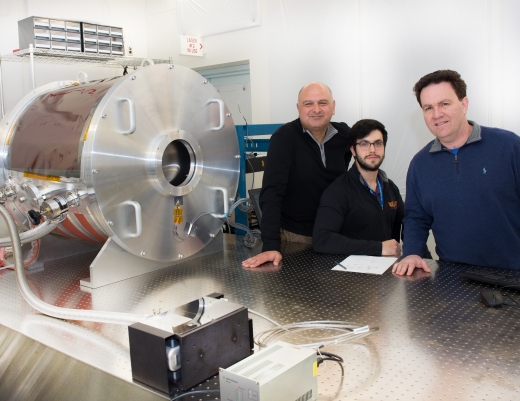
Image: Goddard optics experts Babak Saif (left) and Lee Feinberg (right), with help from engineer Eli Griff-McMahon an employee of Genesis, have created an Ultra-Stable Thermal Vacuum system that they will use to make picometer-level measurements. Credits: NASA/W. Hrybyk.
No observatory yet built, including JWST, has been built that can meet such demanding requirements for stability. But the High-Speed Interferometer has allowed the GSFC scientists to measure dynamic changes across the mirror and structural components. What Feinberg and Saif bring to the table are new algorithms that can take the level of dynamic movement measurement down to 25 picometers, about twice what will eventually be required.
This is measurable progress toward the goal:
“These future missions will require an incredibly stable observatory,” said Azita Valinia, deputy Astrophysics Projects Division program manager. “This is one of the highest technology tall poles that future observatories of this caliber must overcome. The team’s success has shown that we are steadily whittling away at that particular obstacle.”
Working with 4D Technology, GSFC’s team has produced a ‘speckle interferometer’ that allows measurements on both reflective and diffuse surfaces at the picometer-level. The Goddard team is now analyzing its performance in a thermal vacuum test chamber that can control temperatures to the 1 millikelvin level. The plan moving forward is to test items within the chamber to see if the 12-picometer goal is within reach. “We’re getting there,” says Saif.
The key in this testing regime is to test at the same level across the entire structure of the telescope, not just movement between its mirrors. These HSI tests are encouraging, leveraging an instrument developed to work with the Webb telescope’s 18 mirror segments, mounts and supporting structures. Splitting light and recombining it to measure the effects of motion and vibration, the HSI allows the scientists to examine changes across the entire telescope.
The introduction of the speckle interferometer now points to the 12-picometer accuracy our future missions will demand. This is good news all around for atmospheric biosignature analysis.

The Likelihood of Massive Exomoons
Are there large moons — perhaps Earth-sized or even bigger — around gas giant planets in habitable zones somewhere in the Milky Way? It’s a wonderful thought given how it multiplies the opportunities for life to find a foothold even in systems much different from our own. Centauri Dreams regular Andrew Tribick recently passed along a new paper that addresses the question in an interesting way, by modeling moon formation and orbital evolution under widely varying conditions of circumplanetary disk composition and evolution.
We’re entering new terrain from this site’s perspective, because I can’t recall going deeply into circumplanetary disks before, at least not in the exoplanet context. But Marco Cilibrasi (Università di Pisa, Italy) and colleagues take us through the necessary background issues. We have two primary models for giant planet formation inside a protoplanetary disk, one being core accretion, when collision and coagulation occurs among dust particles to build up a planetary embryo. The other is gravitational instability, when a gaseous clump collapses into a planet.
We learn from Cilibrasi et al. that both of these approaches to gas giant formation predict that circumplanetary disks will form around planets in the latter stages of their formation. Here we have to be cautious, because circumplanetary disks do not track precisely with the behavior of their larger cousins around stars. The circumplanetary disk (CPD) receives a constant influx of gas and associated dust from the upper layers of the protoplanetary disk, the result of gas accretion onto the forming gas giant. We can take the moons of Jupiter as our local analog of this process. Indeed, understanding a CPD is crucial to make sense of moon formation.
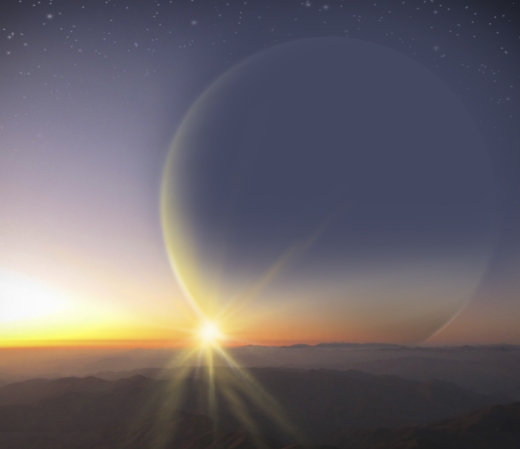
Image: An artist’s rendition of a sunset view from the perspective of an imagined Earth-like moon orbiting the giant planet, PH2 b (a planet confirmed by the Planet Hunters project). The scene is spectacular, but how likely is it that gas giants would have moons beyond Mars size? The answer to the question awaits further work in exomoon detection, but the Cilibrasi paper sees massive moons as a serious possibility. Credit: H. Giguere, M. Giguere/Yale University.
A few interesting things about the Galilean moons: We know that Io is rocky, while the three outer satellites contain a good deal of water ice. The paper points out that icy satellites can only emerge from a circumplanetary disk with temperatures that have dropped below the water freezing point. But simulations of such CPDs show temperatures as high as several thousand Kelvins. This is an indication that the Galilean moons must have formed very late in the process, when Jupiter had substantially cooled and the circumplanetary disk was beginning to dissipate.
Cilibrasi and colleagues performed hydrodynamic simulations that varied the conditions in the circumstellar as well as circumplanetary disks. 20,000 systems were put into play to study the formation, migration and further accretion of the resulting ‘satellitesimals.’ What happens is striking, for because of the continuous influx of dust from the CPD, high-mass satellites form and migrate into the planet, polluting its atmosphere with metals. From the paper:
Our results show that the moons are forming fast, often within 104 years (20 % of the population), which is mainly due to the short orbital timescales of the circumplanetary disc. Indeed the CPD completes several orders of magnitude more revolutions around the planet than the protoplanetary disc material can do around the star at the location of Jupiter. Due to the short formation time, the satellites can form very late, about 30% after 4 dispersion timescales, i.e. when the disc has ? 2% of the initial mass.
During this period of formation, the circumplanetary disk continues to cool off, finally allowing icy moons to form. In fact, the Cilibrasi simulations show that 85 percent of surviving moons contain water ice. The authors found that the satellites lost to the forming planet account for 0.3 Earth masses on average, up to 10 Earth-masses in some cases, thus contributing to the abundance of heavy metals found at Jupiter. But the high mass of the satellites formed by these simulations is an encouraging result.
Even though surviving satellites form late, when the circumplanetary disk has dwindled to about 2 percent of its initial mass, the moons that form out of this late process can be massive, as the paper notes, a distribution “peaking slightly above Galilean masses, up until a few Earth-masses.” This should put the moons around close-orbiting gas giants within range of projects like the Hunt for Exomoons with Kepler. As for exomoons in a habitable zone and the interesting astrobiological implications they offer, we can hope that future breakthroughs in instrumentation will allow us to test these findings.
The paper is Cilibrasi et al., “Satellites Form Fast & Late: a Population Synthesis for the Galilean Moons,” submitted to Monthly Notices of the Royal Astronomical Society (preprint).

Europa’s Surface: Problems for a Lander?
What do asteroids 44 Nysa, 64 Angelina and the Galilean satellites Io, Europa and Ganymede have in common? They are all Solar System objects without an atmosphere that are highly reflective. They are also the subject of study in a new paper from Robert Nelson (Planetary Science Institute) that investigates a feature common to all: At small phase angles (the angle from the Sun to the target being observed), they show negatively polarized light.
Light reflected from objects in the Solar System is usually polarized, meaning that the electric and magnetic vibrations of the electromagnetic wave occur in a single plane. The amount of polarization depends upon the reflective material, but also on the geometry, as a good astronomy textbook makes clear (I’m checking against Karttunen et al.’s Fundamental Astronomy, 6th ed., 2016).

Image: The phases of Rhea. Emily Lakdawalla used these Cassini images to explain phase angle in a useful 2009 backgrounder. Her caption: The angle from the Sun, to a moon, to the observer is called “phase angle.” This montage shows Saturn’s moon Rhea as seen by Cassini through a clear filter at a variety of phase angles. The images have been resized to a constant pixel scale and rotated so that the terminator is up-and-down; the images sample a variety of latitudes and longitudes. Credit: NASA / JPL / SSI / montage by Emily Lakdawalla.
Polarization at phase angles of greater than about 20° from a body without an atmosphere are positive, while closer to opposition, the polarization is negative. Looking at the polarization behavior of the Jovian moons and asteroids he studies, Nelson and team deduce that their long-observed negative polarization at low phase angles can be explained by extremely fine-grained particles with void space above 95 percent. The surface material, in other words, would feature grain sizes on the order of the wavelength of light of the observations, or a fraction of a micron.
The inference is that these objects are covered with material that is less dense than newly fallen snow. This is a significant result, given that in the long term, we have hopes of placing a lander on Europa that can explore some of the intriguing surface material that may represent upwellings from the ocean below. The question becomes: Would a lander simply sink into the surface before it could do its work?
“Of course, before the landing of the Luna 2 robotic spacecraft in 1959, there was concern that the Moon might be covered in low density dust into which any future astronauts might sink,” Nelson said. “However, we must keep in mind that remote visible-wavelength observations of objects like Europa are only probing the outermost microns of the surface.”

Image: This enhanced-color view from NASA’s Galileo spacecraft shows an intricate pattern of linear fractures on the icy surface of Jupiter’s moon Europa. Credits: NASA/JPL-Caltech/ SETI Institute.
Notice that three Galilean satellites are implicated in this work, meaning that we may have comparable issues at Io and Ganymede. Nelson’s reminder of the Luna 2 landing has in turn reminded me of a 1963 novel by Jeff Sutton called Apollo At Go, an extrapolation based on where the manned space program was at that time of what a lunar landing might involve. Here, too, we had dust as a major feature, this time of a science fiction plot. Indeed, the cover blurb for the book includes this look at a projected first lunar landing:

They were hurtling over it, hurtling and dropping. He fought his harnessing to learn closer to the port… There a small crater, here a hill, a crevice, a milky rectangle that looked absolutely smooth and rock hard — this was an inferno without fire, a hell, the architecture of a maddened nature. The House of Lucifer…
“Zero percent fuel,” Kovac rapped out edgily.
“May says zero on the fuel. Still going down. Trying to hold steady, but can’t. Ash looks deep, deep… Rocks right next to us jagged and — Oh, there she goes… main engines off. Small jets can’t… We’re falling…”
I would think ‘zero percent fuel’ would indeed make Kovacs’ voice a bit edgy.
Sutton, a newspaperman, public relations professional and former Marine, may have been wrong about the dangers posed by the lunar surface, but he was spot on in a different regard. He sets up his Moon landing on July 8, 1969, just twelve days before the actual event. And as to the dust, he was actually writing before we had enough data from the Soviet Luna program and the Surveyor landings to ease scientists’ worries. Let’s hope we’re as well informed about Europa’s surface against the day when our first robotic lander sets down there.
The paper is Nelson et al., “Laboratory simulations of planetary surfaces: Understanding regolith physical properties from remote photopolarimetric observations,” Icarus Vol. 302 (1 March 2018), 483-488 (abstract).

On Ursula Le Guin (1929-2018)
Thinking about Ursula Le Guin takes me to a single place. It is a snow-driven landscape, a glaciated world of constant winter called Gethen, whose name means ‘winter’ in the language of its people. I was reading The Left Hand of Darkness while snow pelted down outside one afternoon in upstate New York, waiting for my wife to get back from her teaching job, nursing a cup of tea and finding my mental location fusing with Le Guin’s fascinating world.
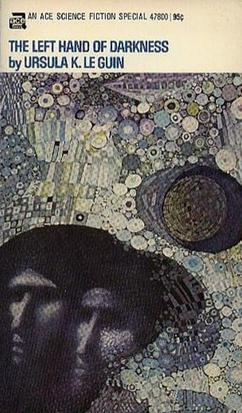
For The Left Hand of Darkness was a spectacular introduction to Le Guin. I had seen her name and even had, somewhere in the stacks, a copy of her first novel, Rocannon’s World (1966), part of an Ace Double that I never got around to reading. The Left Hand of Darkness came out in 1969 but it was in the late 70’s that I read it. I had been through “The Word for World is Forest” when reading Again, Dangerous Visions (1972), one of Harlan Ellison’s anthologies, and although it won a Hugo Award in 1973, I hadn’t found it as much compelling as didactic and all too linked to its era.
I just wasn’t, in other words, prepared for The Left Hand of Darkness, which explores a world in which the inhabitants have no fixed sex. I had read Samuel Delany’s Triton (1976), which deals in some of the same themes, without enthusiasm — I would learn later that Delany saw connections between the novel and Le Guin’s later novel The Dispossessed (1974) — although positing a world where people can change appearance and gender at will provided Delany with vast terrain for exploration.
Image: Front cover of the first edition, with art by the Dillons. Cover depicts two faces against an abstract background. Credit: Wikimedia Commons.
What made The Left Hand of Darkness stand out for me was simply the quality of its prose. Le Guin wrote the novel without sacrificing narrative flow, mining her subject with the gaze of a person who had been raised by two anthropologists (her mother’s book Ishi in Two Worlds (1960) had been widely acclaimed for its look at Californian Indian culture), but she was much more than a chronicler of scientific detail. A dispassionate eye couples in the novel with an explorer’s growing wonderment at place, at people. And the language…
Even as I think this the world’s sun dims between clouds ragathering, and soon a flaw of rain runs sparse and hard upriver, spattering the crowds on the Embankment, darkening the sky. As the king comes down the gangplank the light breaks through a last time, and his white figure and the great arch stand out a moment vivid and splendid against the storm-darkened south. The clouds close. A cold wind comes tearing up Port-and-Palace Street, the river goes gray, the trees on the Embankment shudder. The parade is over. Half an hour later it is snowing.
I can’t speak about The Dispossessed (1974) because I’ve never read it. In fact, there is a great deal of Le Guin I haven’t read. But when the writer died on Monday, I was reminded of my frequent intention of getting into her essays. A new volume called No Time to Spare: Thinking About What Matters had gone on my Amazon wishlist as soon as I saw it in 2017, but I also wanted to cycle back around to her Earthsea series.
As for The Left Hand of Darkness, though, what sticks with me as well as the evocation of place and the vivid sense of snow is the idea behind its civilization. The Hainish universe, beginning with Rocannon’s World, assumes that humans evolved not on Earth but on a planet some 140 light years away called Hain. Because its inhabitants colonized many stellar systems, the possibility was strong that any exploratory vessels from Earth would encounter populations that had been seeded as we had on their worlds. The effort becomes one of re-creating a lost interstellar civilization, using starships traveling close to the speed of light.
I’m told that the ansible was introduced in Rocannon’s World as a way of communicating instantaneously, so a civilization otherwise bound by lightspeed could manage its affairs. Many authors have used an ansible in their work since (and I also think of Dave Langford’s science fiction news and tip-zine of the same name). Le Guin’s galactic civilization becomes known as the Ekumen by the time of The Left Hand of Darkness, comprising fully 83 worlds.

Image credit: Dana Gluckstein
I like the fact that Le Guin contrasted science fiction, which she insisted could be serious literature, with some of the creative-writing-workshop fiction that is all too easily churned out today:
“The thing to remember, however exotic or futuristic or alien the mirror seems, is that you are in fact looking at your world and yourself. Serious science fiction is just as much about the real world and human beings as realistic novels are. (Sometimes more so, I think when faced with yet another dreary story about a dysfunctional upper middle class East Coast urban family.) After all, the imagination can only take apart reality and recombine it. We aren’t God, our word isn’t the world. But our minds can learn a lot about the world by playing with it, and the imagination finds an infinite playing field in fiction.” Interview, Electric Lit, August 7, 2014
The Left Hand of Darkness took both Hugo and Nebula awards and became a fixture wherever science fiction was taught in the academy, surely the first SF novel to do so. No less a figure than Harold Bloom described the book in his monumental The Western Canon. I may not be the only writer who sees Le Guin invariably through its lens.
The New York Times has a fine obituary for Le Guin, as does the Washington Post, but if you want to get to know her views up close, read John Wray’s interview in the Paris Review. What a fine, spirited person! Here Wray, who is no slouch at working science fictional elements into his own novels, asks her about the genre:
I don’t think science fiction is a very good name for it, but it’s the name that we’ve got. It is different from other kinds of writing, I suppose, so it deserves a name of its own. But where I can get prickly and combative is if I’m just called a sci-fi writer. I’m not. I’m a novelist and poet. Don’t shove me into your damn pigeonhole, where I don’t fit, because I’m all over. My tentacles are coming out of the pigeonhole in all directions.

M-Dwarf Planets: ExTrA and TRAPPIST-1
A new project called Exoplanets in Transits and their Atmospheres (ExTrA) has been set in motion at the European Southern Observatory’s site at La Silla (Chile). Funded by the European Research Council and the French Agence National de la Recherche, ExTrA’s three 0.6-metre telescopes will be operated remotely from Grenoble, France. This is an exoplanet transit effort centered around finding and characterizing Earth-sized planets orbiting M-dwarf stars.
Not an easy task from the ground, as lead researcher Xavier Bonfils makes clear, though if you’re going to attempt it, northern Chile offers optimum conditions:
“La Silla was selected as the home of the telescopes because of the site’s excellent atmospheric conditions. The kind of light we are observing — near-infrared — is very easily absorbed by Earth’s atmosphere, so we required the driest and darkest conditions possible. La Silla is a perfect match to our specifications.”
To do its work, ExTrA weds spectroscopic information to traditional photometry. The collected light from the target star is fed through optical fibres into a multi-object spectrograph. Known as differential photometry, the method involves collecting light not only from the target but also from four comparison stars. The comparison helps the technology filter out atmospheric distortions and effects produced by the instruments and detectors themselves.
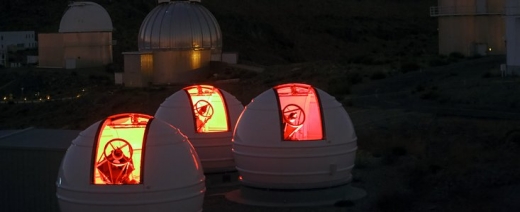
Image: A new national facility at ESO’s La Silla Observatory has successfully made its first observations. The ExTrA telescopes will search for and study Earth-sized planets orbiting nearby red dwarf stars. ExTrA’s novel design allows for much improved sensitivity compared to previous searches. Astronomers now have a powerful new tool to help in the search for potentially habitable worlds. Credit: ESO.
Bonfils adds:
“With the next generation of telescopes, such as ESO’s Extremely Large Telescope, we may be able to study the atmospheres of exoplanets found by ExTra to try to assess the viability of these worlds to support life as we know it. The study of exoplanets is bringing what was once science fiction into the world of science fact.”
Thus ground-based observation continues to increase in precision, soon to be supplemented by space missions like the Transiting Exoplanet Survey Satellite (TESS), the James Webb Space Telescope (JWST) and the European CHaracterising ExOPlanet Satellite (CHEOPS).
Close Look at TRAPPIST-1
And while we’re talking about M-dwarfs, a new paper is out looking at one of the most interesting systems yet discovered, comprising the seven planets around TRAPPIST-1. Lead author Amy Barr (Planetary Science Institute) and colleagues go to work on the interior structures of these planets as well as their tidal heating and convection given what we know about their mass and radius. The balance between tidal heating and convective transport has implications for the mantles of each planet.
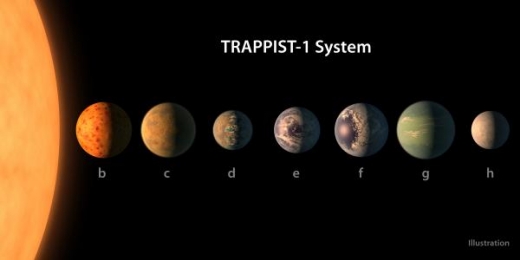
Image: A size comparison of the planets of the TRAPPIST-1 system, lined up in order of increasing distance from their host star. The planetary surfaces are portrayed with an artist’s impression of their potential surface features, including water, ice, and atmospheres. The paper from Amy Barr, Vera Dobos and László L. Kiss shows that planets d and e are the most likely to be habitable due to their moderate surface temperatures, modest amounts of tidal heating, and because their heat fluxes are low enough to avoid entering a runaway greenhouse state. Planet d is likely covered by a global water ocean. Credit: NASA/R. Hurt/T. Pyle.
Given that their orbits are slightly eccentric, there is the possibility of tidal heating, which in the Galilean moons has intrigued us for its possibilities at providing an energy source for life beneath an icy crust, and indeed, the paper notes that “…on planets b, e, f, g and h, life might appear in the tidally heated (subsurface) ocean close to hydrothermal vents.“
In the TRAPPIST-1 system, though, we have much to learn about the composition of the respective worlds. The Barr paper examines the limits of present knowledge:
Assuming the planets are composed of water ice, rock, and iron, we determine how much of each might be present, and how thick the different layers would be. Because the masses and radii of the planets are not very well-constrained, we show the full range of possible interior structures and interior compositions.
The paper is a thoroughgoing examination of the TRAPPIST-1 planets, with planets d and e flagged as the most likely to produce habitable conditions. Here tidal heating would be modest and heat flux low enough to avoid runaway greenhouse conditions:
Planet d is likely to be covered by a global water ocean, and can be habitable if its albedo is ? 0.3. Planetary albedos may be estimated from photometric measurements during occultations (see e.g. Rowe et al., 2008) which may give an additional constraint on the habitability of TRAPPIST-1d. As discussed in Section 5, planet e is likely to have liquid water on its surface, too, according to climate models (Turbet et al., 2017; Wolf, 2017).
Planets f, g, and h, the authors believe, are rich in H2O, possibly containing liquid water oceans beneath a thick ice mantle. Planets b and c likely harbor magma oceans in their interiors. Planet b in particular demands further work, given its proximity to the central star and its “seemingly water-rich composition,” while c may experience eruptions from its magma ocean, a phenomenon that may eventually become detectable.
But note how far we have to go:
Our knowledge of the compositions of the four interior planets, chiefly, their water content, can significantly be improved if their masses can be determined to within ? 0.1 to 0.5M?, which will require further observations of the TRAPPIST-1 system.
The paper is Barr et al., “Interior Structures and Tidal Heating in the TRAPPIST-1 Planets,” accepted at Astronomy & Astrophysics (preprint).

Defining a Brown Dwarf / Planet Boundary
A paper that crossed my desk this morning proves timely in light of our recent discussions about brown dwarfs. Specifically, the question of when to declare an object a planet or a brown dwarf has come up, with the cutoff often cited at about 13 Jupiter masses. Now I see that Johns Hopkins’ Kevin Schlaufman is proposing a cutoff somewhere closer to 10 Jupiter masses, but the idea takes us beyond mass as the determinant of the object’s status.

We tend to turn toward the IAU Working Group on Extrasolar Planets for our ideas on the planet/brown dwarf distinction, though the fact that we can find objects with 10 times Jupiter’s mass both in orbit around stars and also in isolation makes the definition a challenging one. The IAU has defined a planet as an object with a mass below the limiting mass for deuterium fusion that orbits a star or stellar remnant. Objects above this limiting mass have been defined as brown dwarfs, no matter how they formed or where they are located. This is where the 13 Jupiter mass cutoff comes from, although other models have also been proposed.
Image: Johns Hopkins astrophysicist Kevin Schlaufman has proposed a new definition of a planet. Credit: Johns Hopkins University.
But this gets tricky, because much depends on composition — the mass needed for deuterium fusion depends on the object. Under this definition, a metal-poor object of 13 Jupiter masses would be considered a planet, while a metal-rich object of the same mass would be considered a brown dwarf. Nor does this definition take into account formation models.
Schlaufman has made a close study of some 146 planetary systems in his efforts to distinguish between huge planets and tiny brown dwarfs. As the paper says:
This combined sample of 146 giant planets, brown dwarfs, and low-mass stars that have Doppler-inferred masses and transit solar-type primaries (most with homogeneously derived stellar parameters) is the best sample available to calculate the mass at which low-mass secondary companions no longer preferentially orbit metal-rich solar-type primaries.
Mass, in Schlaufman’s view, is simply not enough of a determinant when making the call between planet and brown dwarf. Instead, he proposes looking at the chemical composition of host stars. Giant planets will be found orbiting stars with high metallicity because planets like Jupiter form by building up a rocky core that is later enveloped by a gaseous envelope — this is core accretion. Gas giants are invariably found orbiting dwarf stars that are rich in metals.
Brown dwarfs and stars, on the other hand, form from the top down, clouds of gas collapsing to produce the object through the model referred to as gravitational instability. And indeed, we don’t see brown dwarfs necessarily associated with stars with high metal content. In Schlaufman’s study, objects more massive than 10 times Jupiter mass can be found near stars with varying degrees of metal content. The lack of correlation tells the tale.
Thus the paper:
Celestial bodies with M ? 10 MJup preferentially orbit metal-rich solar-type dwarf stars, while celestial bodies with M ? 10 MJup do not preferentially orbit metal-rich solar-type dwarf stars. A preference for metal-rich host stars is thought to be a property of objects formed like giant planets through core accretion, while objects formed like stars through gravitational instability should not prefer metal-rich primaries. As a result, these data suggest that core accretion rarely forms giant planets with M ? 10 MJup and objects more massive than M ? 10 MJup should not be thought of as planets. Instead, objects with M ? 10 MJup formed like stars through gravitational instability.
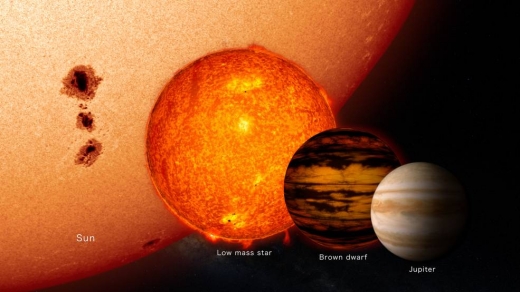
Image: This illustration shows the average brown dwarf is much smaller than our sun and low mass stars and only slightly larger than the planet Jupiter. Credits: NASA’s Goddard Space Flight Center.
Usefully, we will soon be able to test this prediction at a new level of precision. Schlaufman is saying that planets in the mass range of 1 to 10 Jupiters should preferentially be found around metal-rich solar-type dwarf stars, while brown dwarfs between 10 and 80 Jupiter masses should be found around solar-type dwarf stars that span the entire range of metallicity. The European Space Agency’s Gaia mission is expected to find and characterize 21,000 ± 6000 giant planets and brown dwarfs, a sample large enough to put Schlaufman’s theories to the test.
The paper is Schlaufman, “Evidence of an Upper Bound on the Masses of Planets and Its Implications for Giant Planet Formation,” published online by The Astrophysical Journal 22 january 2018 (abstract/preprint).


